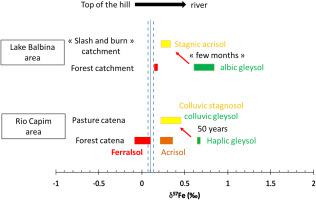Chemical Geology ( IF 3.6 ) Pub Date : 2021-01-19 , DOI: 10.1016/j.chemgeo.2020.120048 Alisson Akerman , Priscia Oliva , Franck Poitrasson , Geraldo Resende Boaventura , Valmir da Silva Souza , Patrick Seyler

|
We examined the consequences of soil erosion processes following deforestation and long-term pasture establishment for soil chemical and physical properties and Fe isotope compositions within two distinct areas in the Eastern and Central parts of Amazonia (near Rio Capim, Para, Brazil and Lake Balbina/Rio Uatuma, Amazonas, Brazil).
For each area studied, soils selected under forest cover and pasture or after recent slash-and-burn practices were investigated. In both forest ecosystems studied, pedogenesis along slopes reflects the evolution of lateritic crust bearing soils (Ferralsol) into iron depleted soils after leaching (Acrisol) and redox processes (Gleysol). Measurements performed by plasma source mass spectrometry show a large range of iron isotope signature within the soil profiles studied at the bottom of the slopes (i.e. foot slope and/or valley soils), under both forest and pasture. Iron isotopic signature in foot slope soils under forest cover (δ57FeIRMM-14 ~ +0.2 to +0.6‰) and pasture (δ57FeIRMM-14 ~ +0.3‰) are significantly heavier than both the continental crust baseline and the reference ferralitic soils from the top of the hill (δ57FeIRMM-14 ~ +0.1‰). This enrichment in heavy isotopes is attributed to the preferential mobilisation and loss of light iron during pedogenesis that involves redox processes in areas periodically flooded at the foot slope and valley soils. Under forest, light iron depletion (where ~90% of the iron was leached in the first metre of the soil) has greater influence on the soil isotopes signature, particularly in foot slope sand-rich soils close to the river system with a remaining Fe having δ57Fe IRMM-14 ~ +0.6‰. Under pasture where soils experienced erosion processes, iron depletion in foot slope and riverside soils is less important (where only a little more than half of the iron was leached in the first metre of the soil) and the resulting δ57FeIRMM-14 ~ +0.4‰ suggests an input of light iron isotopes via colluvic material deposition. This difference indicates that geomorphological changes due to erosion processes following deforestation (i.e. colluvic processes) lead to an “isotopic rejuvenation” of the soils in the valley, mostly apparent within the riverside soils.
For comparison, we investigated isotopic changes in a recently deforested small watershed, near Lake Balbina, Central Amazonia, focusing on riverside soils. Results confirm that the isotopic rejuvenation effect appears within a few months following the first stage of deforestation as a consequence of erosion processes following slash-and-burn practices. Erosion can remove isotopically lighter (i.e. close to the continental crust value of ~0.1‰ in δ57Fe) iron bearing soil material from the top of the hill. When such colluvial soil material accumulates in the bottom of the hills on soils that were initially depleted in light iron isotopes, again due to podzolisation as described in the previous site, it induces an “isotopic rejuvenation” (tending again towards a lighter, continental crust-like δ57Fe signature) of the foot slope and riverside soils, besides changes in landscape morphology, water drainage and soil functioning (i.e. hydromorphic processes). Hence, this study illustrates that Fe isotopes can be used to identify erosion within a deforestation context through “isotope rejuvenation”, even when soil textures make it challenging to unravel.
中文翻译:

森林砍伐对亚马逊地区土壤铁化学和同位素特征的影响
我们研究了毁林和长期放牧后土壤侵蚀过程对亚马逊东部和中部两个不同地区(里约卡皮姆,帕拉,巴西和巴尔比纳湖/巴西亚马逊河的里奥乌塔玛(Rio Uatuma)。
对于研究的每个区域,都对在森林覆盖物和牧场下或最近的刀耕火种后选择的土壤进行了调查。在所研究的两个森林生态系统中,沿坡度的成岩作用都反映了在浸出(Acrisol)和氧化还原过程(Gleysol)后,红土带壳土壤(Ferralsol)向贫铁土壤的演化。通过等离子体源质谱法进行的测量表明,在森林和牧场下,在坡底(即脚坡和/或山谷土壤)底部研究的土壤剖面中,铁同位素的特征范围很大。在森林覆盖脚斜率土壤铁同位素特征(δ 57铁IRMM-14 〜0.2至+ 0.6‰)和牧草(δ 57铁IRMM-14 〜+ 0.3‰)比大陆地壳基线和从山顶参考ferralitic土壤(δ两者显著较重57的Fe IRMM-14 〜+ 0.1‰)。重同位素的这种富集归因于成岩过程中轻铁的优先动员和损失,这涉及在山麓土壤和山谷土壤中定期淹没的区域中的氧化还原过程。在森林中,轻铁的消耗(其中约90%的铁在土壤的第一米中被浸出)对土壤同位素特征具有更大的影响,特别是在靠近河流系统且土壤中残留铁的山坡土壤中具有δ 57的Fe IRMM-14 〜+ 0.6‰。在牧场那里的土壤经历侵蚀过程中,有坡,沿江土壤铁耗尽不太重要(其中只有超过铁的一半在土壤中的第一计浸出一点点),将所得δ 57铁IRMM-14 〜 + 0.4‰表示通过共生物质沉积输入了轻铁同位素。这种差异表明,森林砍伐后的侵蚀过程(即共生过程)引起的地貌变化导致山谷土壤“同位素再生”,大部分在河岸土壤中很明显。
为了进行比较,我们调查了中亚马孙地区巴尔比纳湖附近最近砍伐的小流域的同位素变化,重点是河岸土壤。结果证实,在砍伐森林的第一阶段后的几个月内,由于刀耕火种的侵蚀过程导致了同位素活化作用的出现。侵蚀可以(在δ即接近于〜0.1‰的大陆地壳值除去同位素打火机57 Fe)的铁轴承土壤材料从山顶。当这种冲积土壤物质积聚在最初贫乏轻铁同位素的山丘底部的土壤上时,又由于如前一站点所述的荚果化作用,就会引起“同位素再生”(再次趋向于更轻的大陆壳)样δ 57铁标志),除了景观形态,排水和土壤功能(即水形过程)变化外,还包括山麓和河边土壤。因此,这项研究表明,即使土壤质地使其难以解体,Fe同位素也可用于通过“同位素再生”在森林砍伐环境中识别侵蚀。











































 京公网安备 11010802027423号
京公网安备 11010802027423号